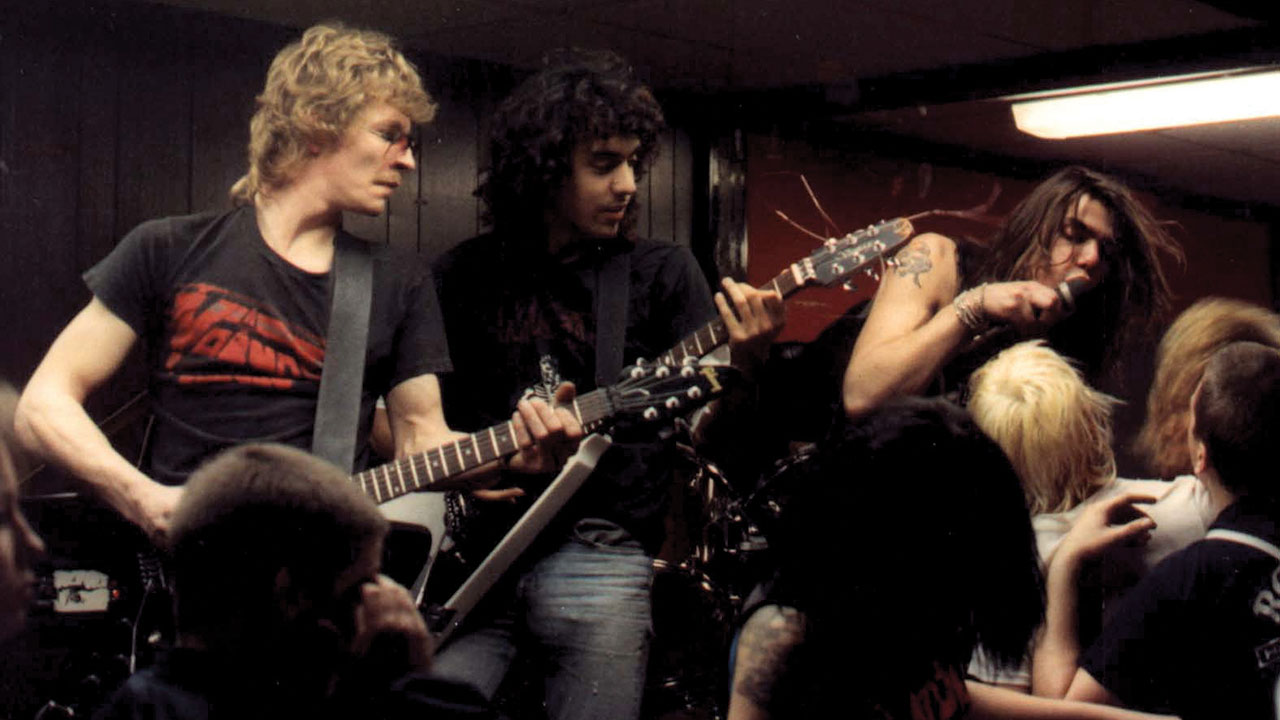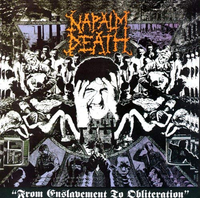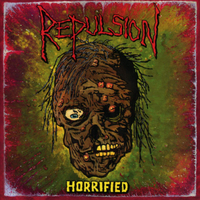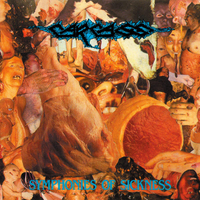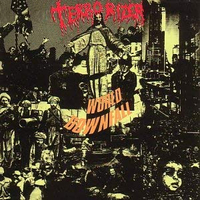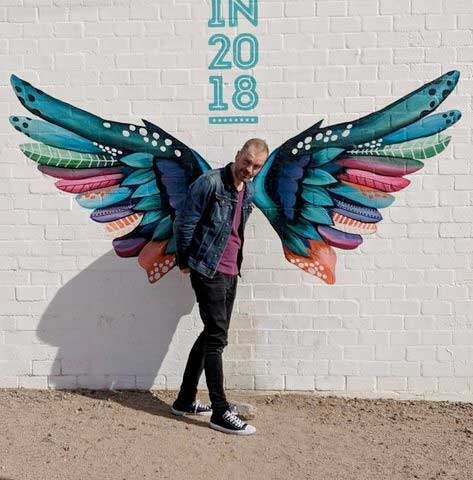In April 1989, the BBC aired a landmark documentary as part of its arts-themed Arena strand. The programme’s two-word title was as direct and to-the-point as the subject it covered: Heavy Metal.
Metal’s great and good lined up in front of the cameras like insects under an entomologist’s microscope: Ozzy, Lemmy, Lars Ulrich, Jimmy Page, Bruce Dickinson, Axl Rose… everyone who was anyone was involved.
Towards the end of the show, things took a turn for the weird. Four suspicious-looking men barely out of their teens perched on a bed in a suburban room plastered with horror movie posters explained how their band, Napalm Death, were taking things to a whole new place.
“You’ve got distorted bass, fast drumming and over-the-top vocals,” says the bassist Shane Embury, in a dry Birmingham accent. “Everything in the band is really extreme. That’s the way you’ve got to be, really.”
To prove this, the film cut to footage of the band rampaging through the title track of their debut album, Scum. With its near-inhuman blastbeats and concrete mixer vocals it sounded less like traditional heavy metal and more like a high speed pile-up on the M6.
The documentary makers neglected to mention that Napalm were spear- heading a new underground movement as revolutionary as thrash had been half a decade earlier. The bastard offspring of British punk, American hardcore and the emergent death metal scene, its name encapsulated its ferocity, brutality and sheer will to challenge: grindcore.
In 2017, nearly three decades later, Napalm Death appeared on the BBC again, this time as part of the channel’s coverage of the Glastonbury Festival, where they were headlining a specially curated extreme metal line-up. Their appearance showed how much things had changed, but also how little – sure, they were being introduced to an audience of hundreds of thousands, but the vast majority still wouldn’t have a clue what the hell it was all about.
More than 30 years after it erupted out of the grotty pubs of Birmingham and the clubs of the American Midwest, grindcore remains metal’s logical end point. Other genres may have challenged it in terms of extremity, but grind has remained constantly ahead of the field.
“The key factor with grindcore is that it is so extreme, it’s not ‘normal’,” says Shane, the heartbeat of Napalm Death since the original BBC documentary. “As the years have gone on, things have changed but extremity keeps on going.”
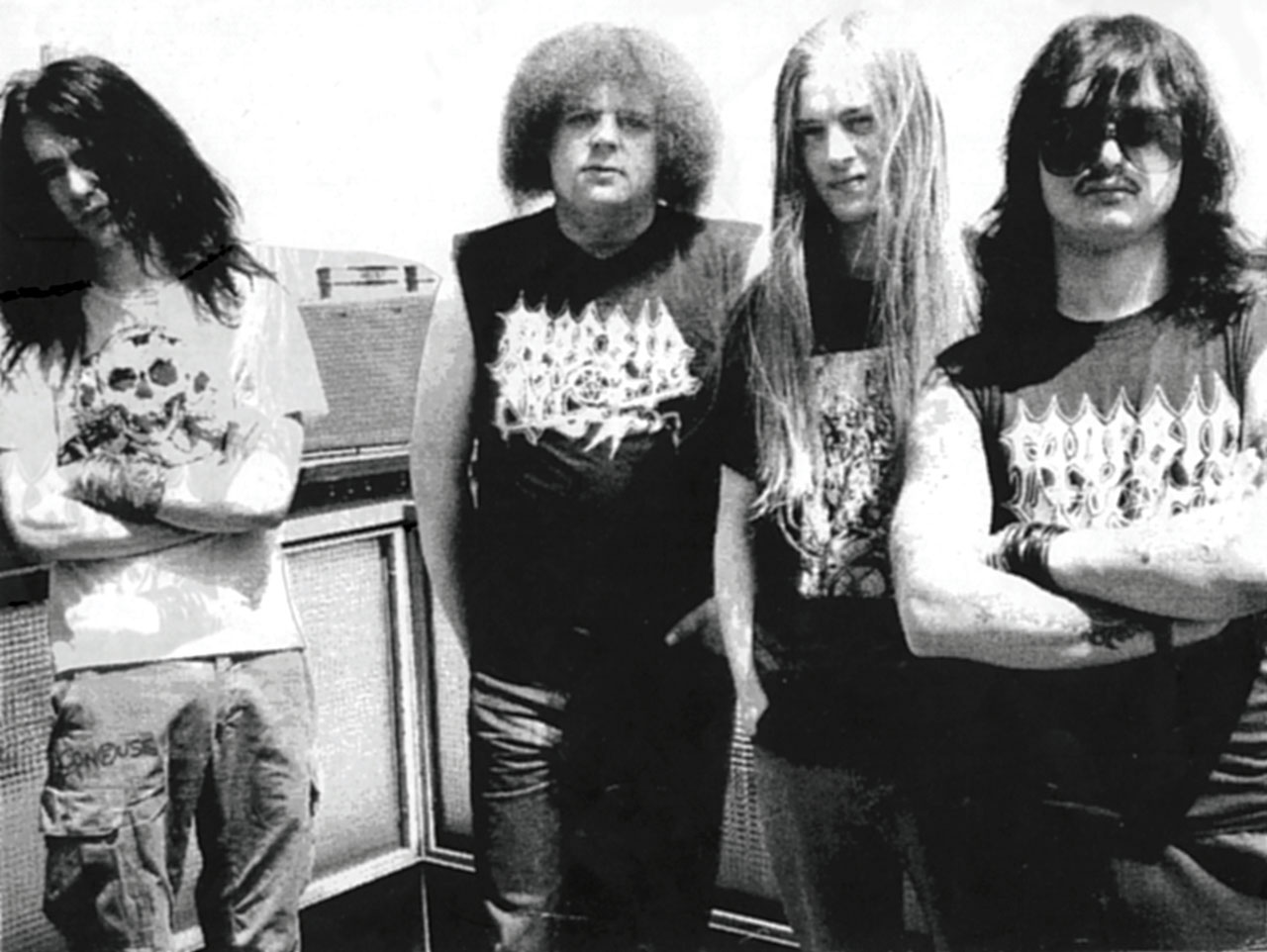
Napalm Death have been the dons of grindcore since the start, but Shane doesn’t take credit for creating the genre. He points towards two pioneering US acts who gave punk and metal a sonic power-up during the first half of the 80s: Boston provocateurs Siege and Flint longhairs Repulsion.
The two bands were coming at things from different starting points. Siege were embedded in the febrile East Coast hardcore scene, while Repulsion were part of the emerging DM scene, tracing their influences back through thrash to the likes of Kiss and AC/DC. But they arrived at the same destination.
“We didn’t sit down one day and say, ‘Let’s start doing blastbeats,’” says Repulsion guitarist Matt Olivo, who co-founded the band with bassist/vocalist Scott Carlson as Tempter in 1984. “It was a day-by-day thing: ‘Let’s take what Venom and Slayer and Metallica are doing to the next level.’”
Repulsion and Siege did not sound alike but had shared characteristics, chiefly raw, unintelligible vocals (Siege’s insectoid and spat out, Repulsion’s guttural and vomited up), and especially inhumanly fast drumming.
“We took the thrash beat and said, ‘Let’s play the song faster,’” says Matt. “Then we’d be, ‘Let’s play it even faster.’ We did demos in ’85 with blastbeats.”
In those pre-internet days, Repulsion were strictly an underground concern. They rarely played outside of Flint, and when they did they only made it as far as Detroit. There were never more than a hundred people in the crowd for their shows.
“Mostly the response was good,” says Matt, “but occasionally you’d get these metalheads who were used to listening to Metallica and Slayer or Judas Priest looking at us and going, ‘This isn’t metal, it’s not punk, I don’t know what the fuck these guys are doing.’”
Repulsion recorded an album in 1986, but no label would release it (it emerged, eventually, in 1989 as Horrified). The band split up soon after. “We were from Flint, Michigan, the middle of nowhere. No label would touch us and there was no prospects for us,” says Matt, who joined the military shortly afterwards. “There was zero interest to sign us. It was just too ahead of its time.”
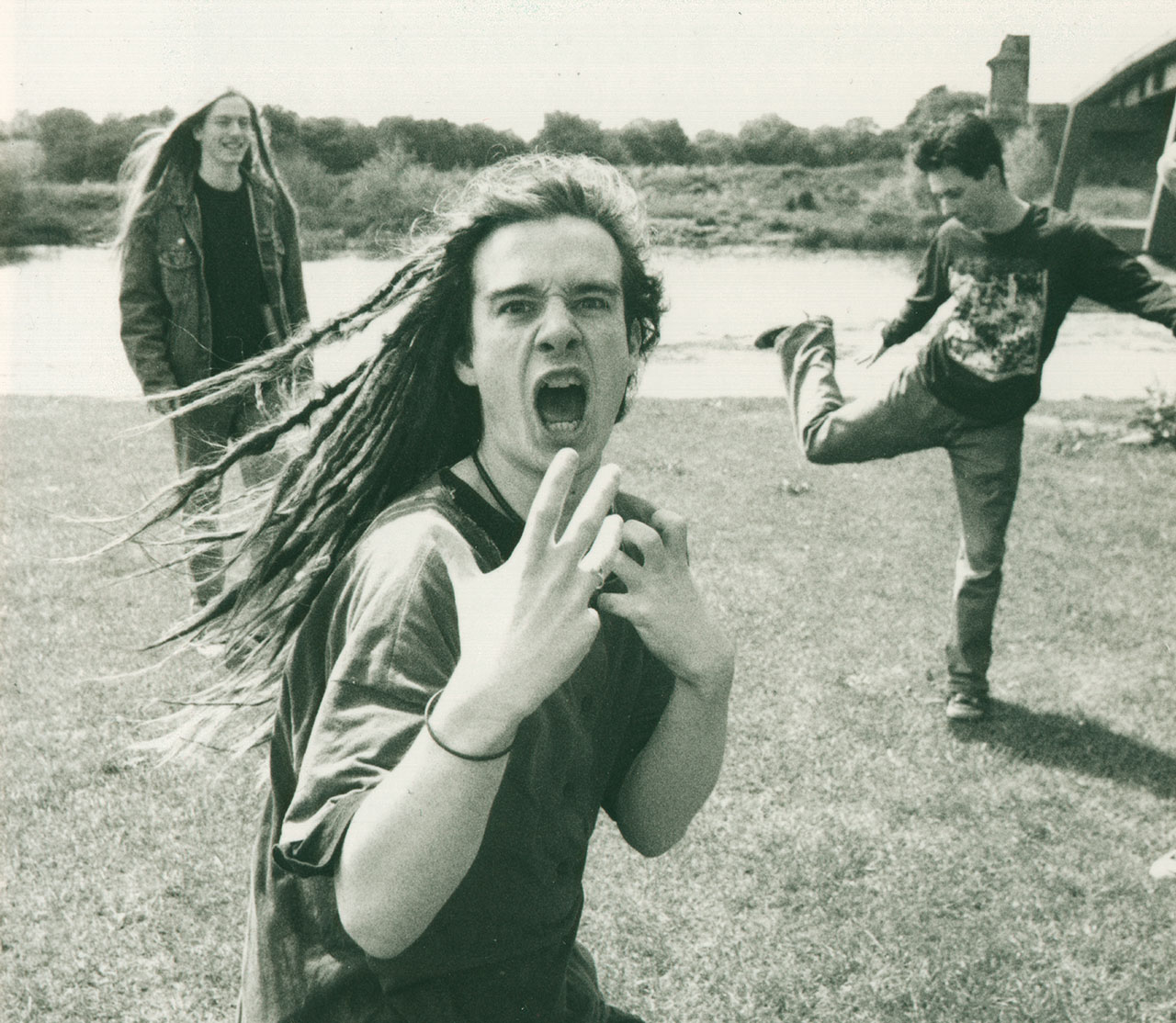
Shane Embury first heard Repulsion in the mid-80s, even before he joined Napalm Death. He was an avid tape trader, part of a global underground network of extreme music fans who’d exchange demos and albums via snail mail – a concept that seems slow and archaic today, but was crucial in metal’s development in the 80s and 90s.
“They were called Genocide at the time,” he recalls. “They were really pushing the sonics. They had death metal influences, but they also had a looseness on the blastbeats, a really punky style. When I met the guys from Napalm, there were definite similarities between the two.”
Shane knew of Napalm Death from the Birmingham punk scene. They’d been founded by bassist/sometime vocalist Nik Bullen and drummer Miles Ratledge in 1981, though they’d had countless line-ups since. Their earliest incarnations were equally inspired by the caustic anarcho-punk of Crass and Throbbing Gristle’s menacing electronic noise, but they’d gradually assimilated more extreme influences such as Repulsion, Siege and Swiss avant-garde thrash visionaries Celtic Frost.
“Napalm were pushing the envelope on speed,” says Shane. “Watching them play live was massively important for me. They were pushing the blastbeats every week, playing faster and faster. There was a childish excitement to it. We were all just vibing on the music.”
Napalm Death were fixtures at The Mermaid, a Birmingham pub that put on gigs by punk and hardcore bands. The Mermaid was an unlikely hothouse for this emerging scene – kindred spirits such as Extreme Noise Terror, Heresy and Doom played there.
“There’d be punks all over the floor, drinking cider, lots of dreadlocks, lots of colourful hair, smell of sick in the toilets,” says Shane. “But it was great - you could see 10 bands for £1.50.”
By mid-1987, Napalm Death were set to unleash their debut, Scum, on the world via recently founded Nottingham label Earache. Its A and B sides were recorded nine months apart by two different line-ups: the former featured Nik Bullen, future Godflesh frontman Justin Broadrick on guitar and vocals and drummer Mick Harris; the flipside featured Mick, vocalist Lee Dorrian, guitarist Bill Steer and bassist Jim Whitely. It was, says Shane, Mick Harris who gave this new noise its name.
“The term ‘grindcore’ stems from Mickey,” he says. “He created that name. His basis for it was fast, distorted noise, but it could also be low as well – it was just a case of how abrasive it sounded.”
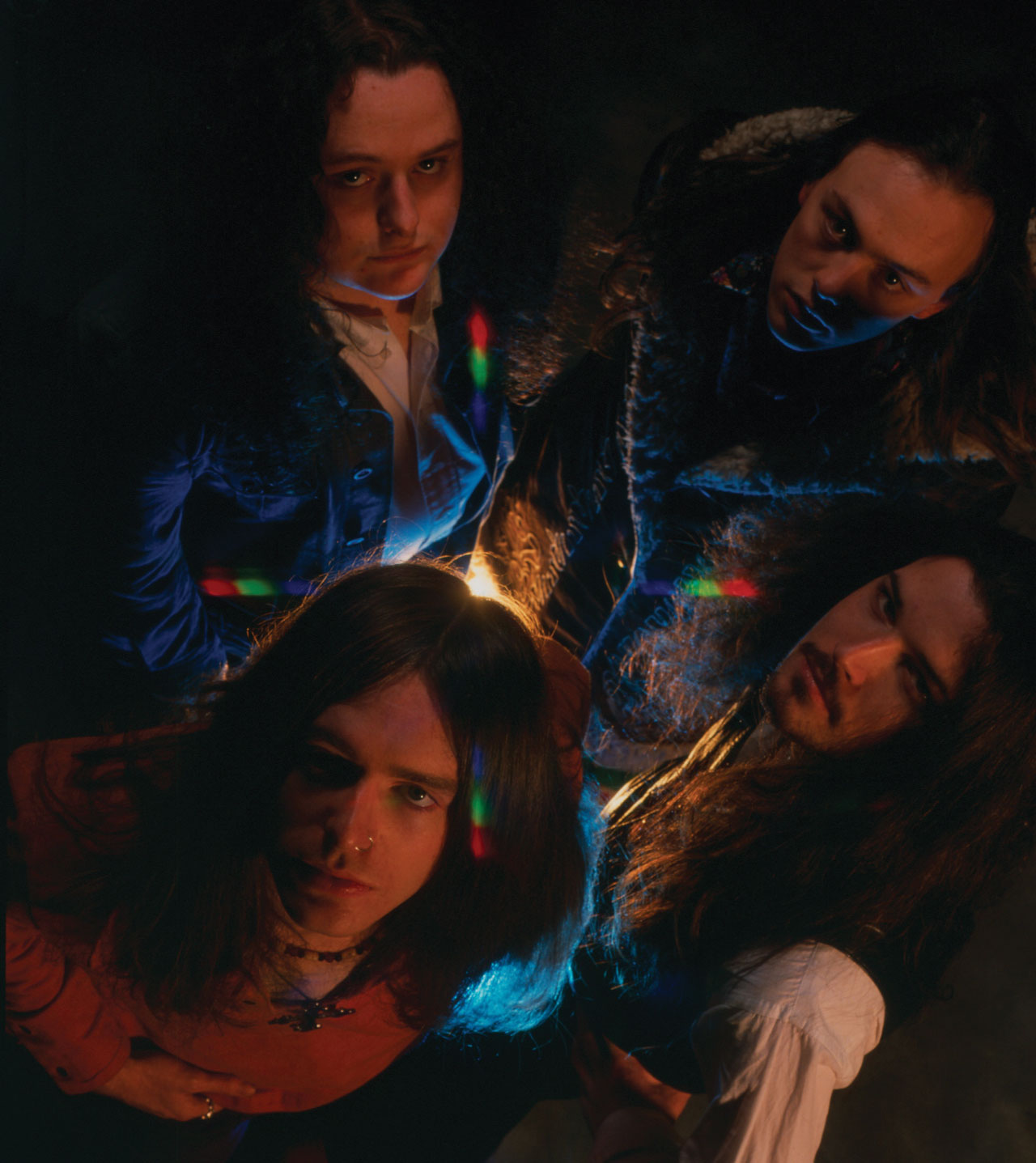
My the time of Napalm’s second album, 1988’s landmark From Enslavement To Obliteration, Shane had replaced Jim Whitely on bass. The album took the filthy-sounding grind of its predecessor to even more outlandish levels.
Despite the reticence of the mainstream media (and resistance from conservative elements of the metal press), grindcore had taken root. Bands like Liverpool’s Carcass (featuring Napalm Death’s Bill Steer), Ipswich’s Extreme Noise Terror and Nottingham’s Heresy were inadvertently redrawing metal’s boundaries.
One unlikely patron of the grindcore scene was influential DJ John Peel, whose nightly Radio 1 show gave airtime to the musical outcasts who wouldn’t normally get played on the station. Peel invited Napalm to the studio to record multiple sessions over the years.
“He liked the extremity of it, he got the challenge of it,” says Shane. “When Peel gave us the thumbs up, a bunch of different people who would never have listened to us got into it. You’d have a Repulsion fan standing next to a Sonic Youth fan at our shows.”
This sonic upheaval wasn’t just a British concern. Repulsion may have split up (they briefly reformed in 1990, without Matt Olivo), but a phalanx of American bands were picking up where they left off: Las Vegas brats Righteous Pigs, Florida’s Assück, Los Angeles’ Terrorizer. Similarly, in Scandinavia the likes of Filthy Christians and G-Anx were spreading the grindcore gospel. In Japan, S.O.B. showed grindcore was a truly global proposition.
The various strands of the grindcore scene were gathered together alongside its death metal counterpart on the 1989 Earache Records compilation, Grindcrusher. The album was a lightning rod for anyone hungry for extremity.
“That record was so important,” says Anders Jakobson, drummer with Swedish grindcore firebrands Nasum. “You’ve heard all this extreme music in the 80s, then suddenly it’s been taken to a whole new level.”
Ironically, as this was happening the scene’s founding fathers were getting restless. In 1990, Napalm Death released their third album, Harmony Corruption. It featured another change of personnel – out went Bill Steer and Lee Dorrian (to focus on Carcass and doom metal outliers Cathedral respectively), in came growler Barney Greenway and American guitarists Jesse Pintado and Mitch Harris.
But an even bigger change came with Napalm’s sound. Many of the condensed punk influences were dispensed with, replaced by a noticeable death metal approach and longer songs.
“We thought it would be too easy just to make another blast album, so we did something else,” says Shane. “It was all choices, but especially Mickey’s. Then funnily enough, he veered off and started listening to Godflesh and Ministry and didn’t want to be in the band anymore.”

Napalm Death’s move away from the style they’d helped forge coincided with a shift in attention from grindcore towards the technical proficiency of death metal and black metal’s brewing Satanic youthquake.
Bands such as New York weed enthusiasts Brutal Truth and Swedish gore fiends Regurgitate kept the grind flag flying, but the scene’s initial impact had quietened down – at least until Nasum released Inhale/Exhale in 1998.
“It was Nasum who really pricked my ears up,” says Shane Embury. “It was their ferociousness. It all seemed fresh and interesting again.”
Inspired by homegrown grind figureheads Filthy Christians and G-Anx, guitarist-turned-drummer Anders Jakobson had formed Nasum in Örebro, Sweden in 1992, recruiting vocalist/guitarist Mieszko Talarczyk a year later. “We started Nasum because there weren’t many grindcore bands at that time,” says Anders.
When Inhale/Exhale was released six years later via US label Relapse, it sent a 10,000 volt charge of electricity through the scene. For Shane, it was a roadmap that joined the past and the future. Napalm instantly hit the reset button. Their next album, Enemy Of The Music Business, was their most vituperative since the late 80s.
Nasum released two more acclaimed albums before their career was cut short by the tragic death of Mieszko Talarczyk in the 2004 Boxing Day tsunami. By that point, the resurgence they’d helped instigate was in full swing, abetted by the likes of Virginia’s Pig Destroyer and masked San Francisco provocateurs The Locust. Weirder still, grindcore’s influence had finally begun to filter into metal’s mainstream.
“I’ve met the Slipknot guys a few times, and they’re totally aware of Napalm, and System Of A Down opened for us at one show in 1997, before they even got signed,” says Shane. “It’s very nice and very flattering, but obviously they mixed it up with different things.”
But grindcore’s biggest triumph is more than just its continued survival, it’s the genre’s worldwide reach. The tape-trading network that helped spark the scene into life in the 80s has been superseded by the internet, connecting fans and bands like never before.
Today, grindcore isn’t just the preserve of Northern Europe and America – fertile local scenes can be found in Brazil, Russia and Southeast Asia, all linked by the same intention.
“Grindcore is protest music,” says Vijesh Ghariwala of Singapore’s Wormrot, who have released three albums on Earache. “Even if you’re not a political band, or even if you’re not from a poor country, it allows you to get things out of your system that other forms of music don’t.”
Unlike many of metal’s other subgenres, grindcore never dates. Its forward momentum, like its velocity, doesn’t allow it to sit still. “It regenerates itself every few years,” says Shane. “There’s always that need to push things to an extreme – and it has got more and more extreme over the last 30 years. If you’ve got that particular gene in you that craves that insane noisy sound, that’s the lasting appeal.”
Three decades after its inception, the success of Napalm Death and the bands they inspired prove as much. Long may they grind.
